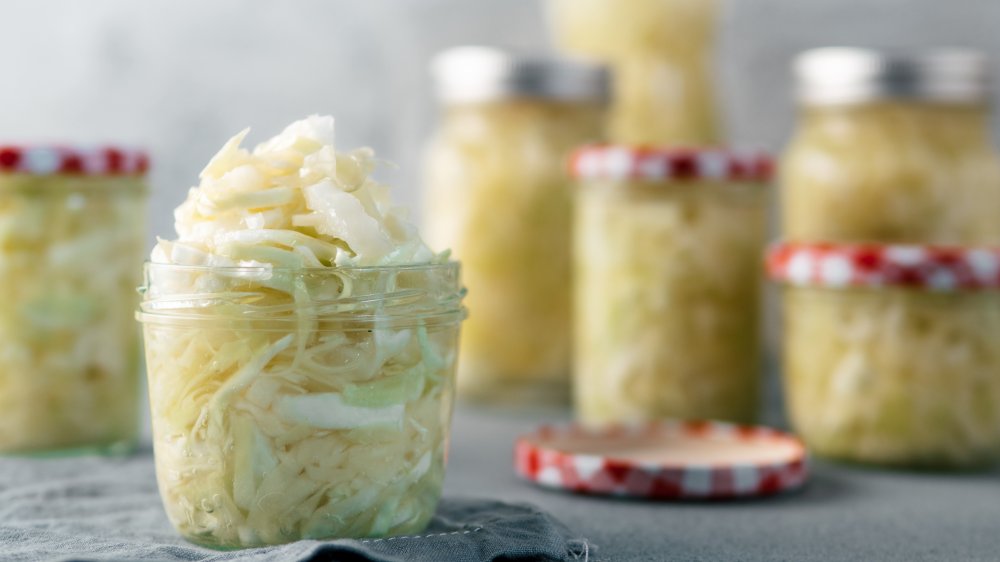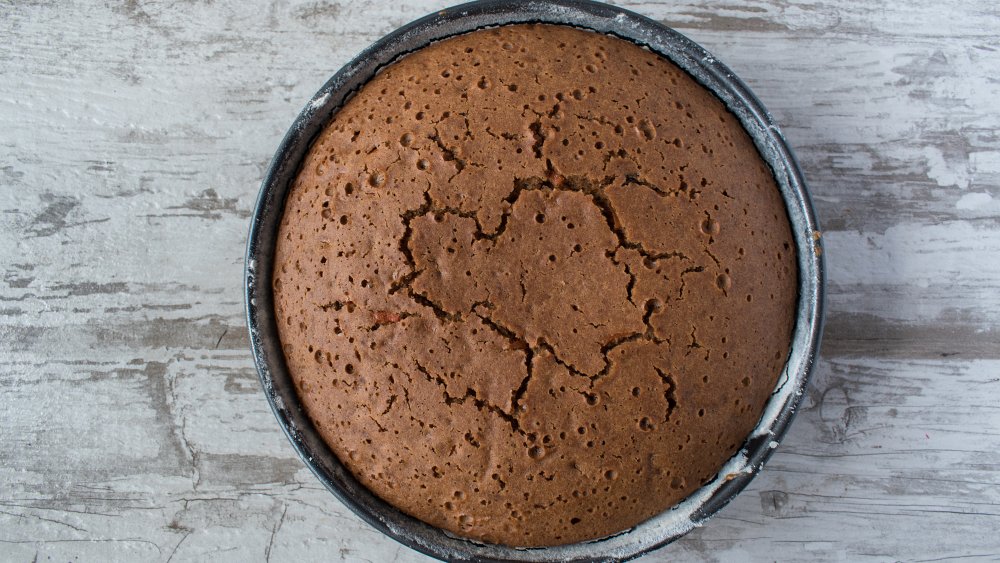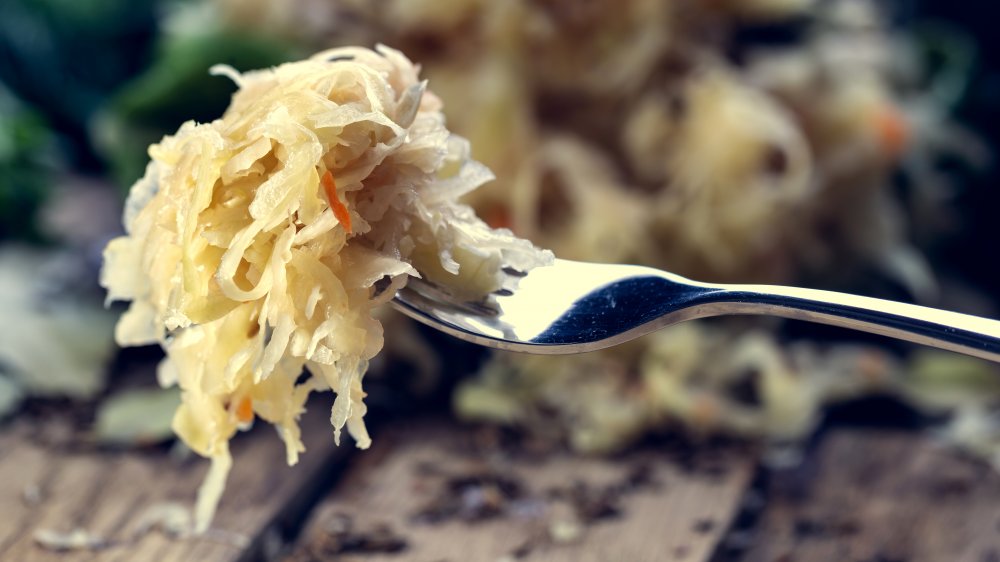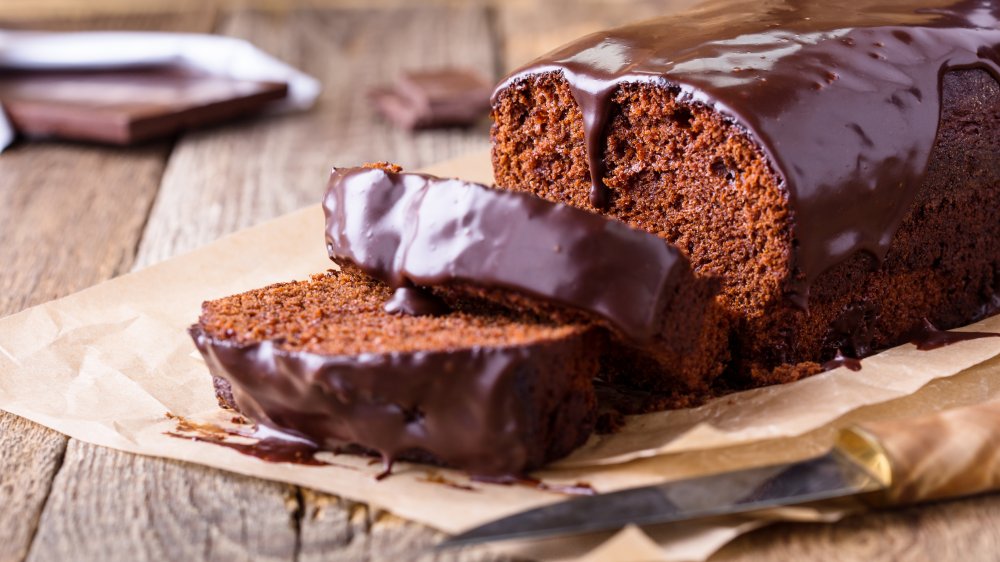The Unexpected Ingredient That Will Change Your Chocolate Cake Forever
From mayonnaise, to soda, to ice cream, there is a long list of unusual ingredients that can be mixed into cake batter with surprisingly delicious results. This unexpected add-in, however, takes the proverbial cake. Thanks to the addition of sauerkraut — yes, sauerkraut — your chocolate cake will never be the same (via The Spruce Eats).
Many nontraditional takes on cake can be traced to the Great Depression, earning these unconventional cakes the moniker "Depression cake." Given a scarcity of standard baking ingredients, like eggs and butter, cooks were forced to get creative when their rations ran low (via Today). Wide Open Eats explains that, like vinegar, sauerkraut was one of grandma's Depression-era tricks for enhancing the rich flavor of a chocolate cake by adding a hint of acid.
The Old Foodie offers a different report for how sauerkraut became cake-worthy. Legend holds that an excess of sauerkraut in the 1960s led to the USDA's Surplus Committee tasking school cafeterias with incorporating the canned 'kraut into their menus. Yet another take, according to Amanda's Cookin', is that sauerkraut cake started as a prank. Rumor has it that sauerkraut in cake was a popular gag ingredient for April Fool's Day in the '60s.
Sauerkraut adds acidity to a cake
No matter its origin story, sauerkraut chocolate cake has weathered the sands of time. Bakers today are turning to retro recipes with good reason — sauerkraut belongs, believe it or not, in chocolate cake.
Sure, we all know and love sauerkraut as a condiment atop hot dogs or brats. But what exactly is it? Essentially, sauerkraut is cabbage that has undergone fermentation. Initially, circa 2,000 years ago, the fermentation process was key to keeping fresh heads of cabbage from spoiling (via Healthline). Today sauerkraut is no stranger to recipes (albeit of the savory sort), from a toasted reuben, to pizza (via Taste of Home). Sauerkraut is also a famous filling for pierogis and blintzes (The Spruce Eats).
Just why, you might be thinking, would adding salty, fermented cabbage to cake be a good idea? First things first: Sauerkraut chocolate cake does not taste like sauerkraut, or overly sour at all, for that matter. The slight acidity sauerkraut does impart works to balance the sweetness of the cake, not overpower it (via Democrat & Chronicle).
According to Wide Open Eats, during World War II, vinegar was commonly combined with baking soda to replace an egg in cake recipes. The resulting "wacky cake," as these ad hoc desserts came to be called, was light and airy — and slightly acidic. The acidity brought out a rich, complex flavor in chocolate cakes. Sauerkraut can have the same delicious effect.
Sauerkraut makes cake surprisingly moist
According to Delish, this secret ingredient may be mistaken for coconut by unsuspecting eaters, earning it a comparison to German chocolate cake with its quintessential coconut-pecan layers and frosting. Adding one cup of drained, rinsed, and finely chopped 'kraut to your cake batter introduces a moist and not dense texture. Wide Open Eats recommends pulsing the sauerkraut in a food processor before stirring it into the batter.
When you think about it, adding vegetables to cake to increase the moisture content is not without precedent. Shredded beets, carrots, and zucchini are vegetable all-stars in the desert game (via Amanda's Cookin').
A perfectly moist cake calls for an complementary frosting. The Spruce Eats tops their sauerkraut cake with a luscious cream cheese spread. They recommend mixing the cream cheese with melted semisweet chocolate to keep the chocolatey goodness going. Food uses powdered cocoa instead of baker's chocolate. Not into cream cheese frosting? You can always use sour cream (via Cookie Madness) or even mayonnaise (via Amanda's Cookin'). The sour cream version has been likened to a layer of fudge.
Salt is sauerkraut's key ingredient
Dish 'n' the Kitchen credits salt as the reason for this weird-sounding cake's success. Salt is the key ingredient for fending off harmful microbes while cabbage transforms into sauerkraut, and it also makes the finished ferment taste delicious (via Nourished Kitchen).
In the case of sweets, salt is actually critical for experiencing full flavor. Each of our taste buds host 50 to 100 taste cells which distinguish the foods we eat — like a slice of sauerkraut chocolate cake — into individual flavors of salty, sour, sweet, bitter, and umami. Research supports that sodium plays an important role in activating our tongue's taste buds for sugar. According to Delish, our tongue's sugar receptors can only carry sugar into cells with the help of salt. Salt also helps to mellow out the natural bitterness found in cocoa (via Science Focus). In adding salty sauerkraut to chocolate cake, you're ultimately boosting flavor, and there's nothing bad about that.



